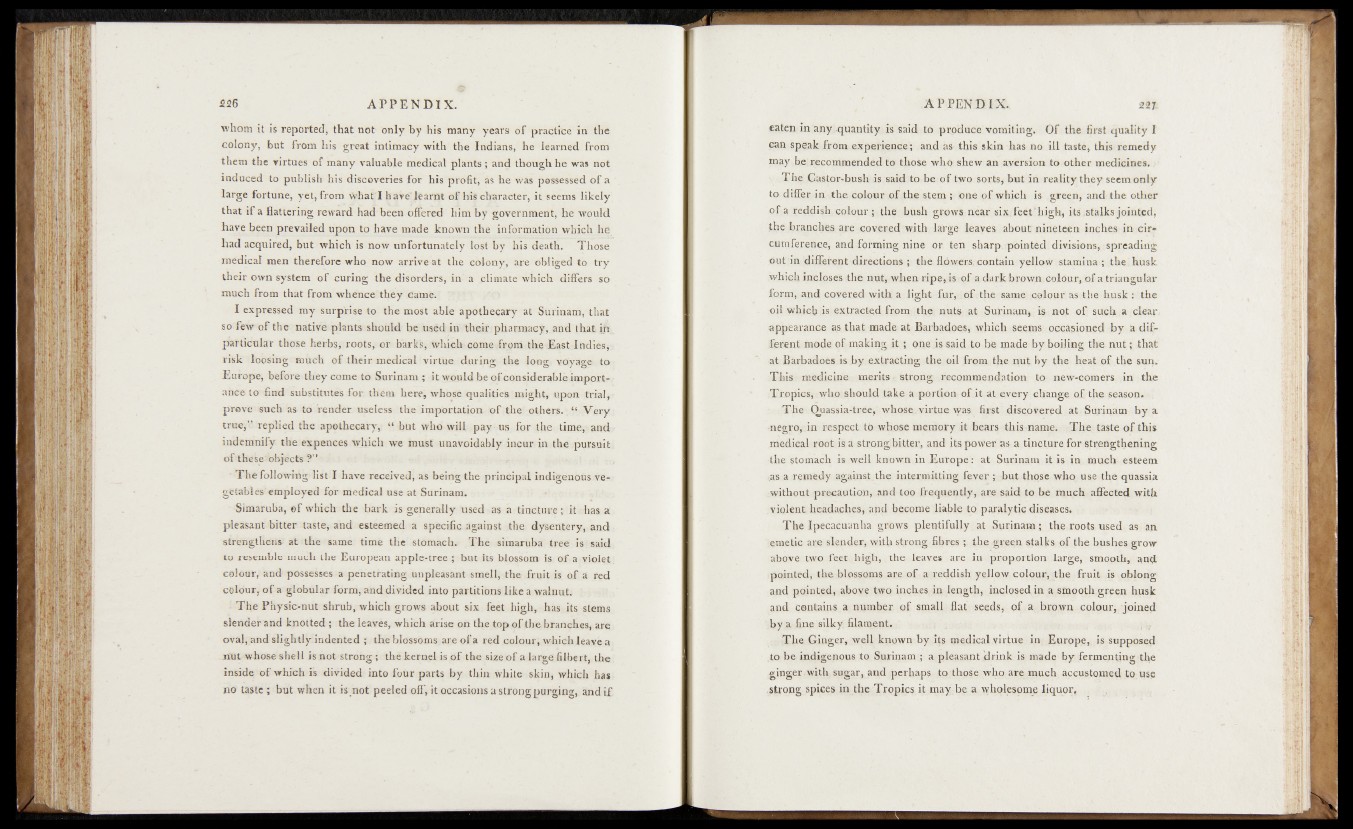
■whom it is reported, that not only by his many year» of practice in the
colony, but from his great intimacy with the Indians, he learned from
them the virtues of many valuable medical plants ; an^ though he was not
induced to publish his discoveries for his profit, as he was possessed of a
large fortune, yet, from what I have*learnt of his character, it seems likely;
that if a flattering reward had been offered him by government, he would
have been prevailed upon to have made known the information which he,
had acquired, but which is now unfortunately lost by his death. Those
medical men therefore who now arrive at the colony, are obliged to try
their own system of curing the disorders, in' a climate which differs so
much from that from whence'they Came. gj
I expressed my surprise to the most able apothecary at Surinam, that
so: few o f the native plants should be usée! in their pharmacy, and that in
particular those herbs, roots, or barks, wlueh comevfrqm the East Indiés*.
risk loosingoeüch of their medical virtue during- the long* voyage to
Europe, before they come to Surinam ; it would be oFconsiderable import-*
ance-to End'Substitutes for; them here, whose qualities"Haight* «pon itrialÿf
prove such as to Vender useless the importation, o f .the* others. ; ‘W e r y
true,’’ replied the apothecary, “ bût who will , pay- ns for the time^and-
indemnify the expences which we must unavoidably incur in the pursuit;
of these objects ?” I
* The following*list I have received, as being the principal indigenQÓs ve- >
getabiês’etoployed for medical use at Surinam.
Simaruba, Of which the bark is generally uaed as a tincture ; it/.has a
pleasant bitter taste, and esteemed a specific against the dysentery, and
strengthens at the same time tlie stomach. The simaruba tree is said
to resemble much the European apple-tree ; hut its blossom is of a yioie.t.
colour, and possesses -a-penetrating unpleasant smell, the fruit is o f a red
colour, of a globular form, and divided into partitions like & walnut.
- The Physic-nut shrub, which grows about six feet high, has its stems
slender and knotted ; the leaves, which arise on the top of the. branches, are;
ovaj, and slightiy:indented ; the blossoms. are of a red colour* which leave a
liut whose shell is not strong ; the kernel is of the size of a large filbert, the
inside of which is divided into four parts by thin White skin, which has
no taste ; but when it is not peeled off, it occasions a strong purging, and i£
eaten in 'ajiyJ.quantity is said to prptiueevomiting. Of the first quality I
Can speak .from experience ; and as-. this skin has no ill taste, this remedy
may b,e; recommended to those who shew an aversion to other medicines, x 1
v it The; C^stor>rhush .is said to -be of two setts,* but in reality they seem only
to differ in-.the colour of the stem ; one of which is green, and the other
of»a reddish, colour ; > the bush grows near six, feet * high* its jstalks jointed,
the branches are covered with $ large leaves about nineteen inches in circumference,
and forming nine or. ten. sharp.rpointed divisions, :spreading
out;in different directions ; the flowers, contain yellow stamina ; the. husk
whieh incloses thé nut, when ripe,Ast^#dark brown colCur, of a triangular
form, and covered with a light fur, ;qfvthfi same, colour; as the husk: the
oil whieb is extracted from* thevnotSi a t Surinam* is . not o f such a clear.
appearance a,s that made at Barbadoes, which Seetqs occasioned by a different
mode of making ft.; ope is said to be made by boiling the nut; that
at Barbadoes is by extracting the oil from the Opt; fay the heat of the sup.
Thisr medicin&f sp r it s « strong recommendation „tq* new-comers in the
.Tropics, who. should take a portion of it at every change o f the season.
. The Quassia-treef whose.,virtue was first discovered at, Surinam by a
negro*.in respect to whose memory it bears this name. The taste of this
medical root is a strong bitter, apdits power jasja tincture for strengthening
the stomach is well known in,Europe': at,Surinam it is in much esteem
as a remedy agaiottithe intermitting fever ; but those who use the quassia
without precaution, and too frequently, are said to be much affected with
. violent, headaches, and become liable to paralytic diseases* ;
Tfae Ipeoacuanlra gttows plentifully, at Surinam ; theepots used, as ;an
emetic are slender, with strong .fibres ; the green stalks of the bushes grow
above two feet%|iigh, the leaves att: in proportionlarge, smooth, add
pointed, the blossoms are o f a reddish yellow colour, .the fruit is oblong
and pointed, above two inches, in length, inclosed,ip a sfnoqth.green husk
and contains, a number qf small flat seeds, of a brown colour, joined
hyp fine silky.filament. : , , ,f
: The Ginger, well known by. .its medical virtue i^;JÉurope,. ia supposed
to be indigenous to Suripam; a pleasant Brink; is made by ferpieptgng the
ginger with, sugar, and perhaps to those who are much accustomed tq-use
strong spices in the Trqpics it may be a wholesome liquor* , , , !tf .s